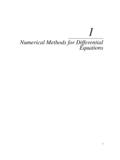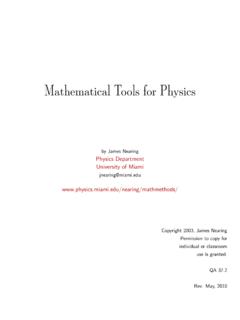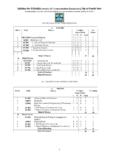Transcription of Introduction to Numerical Methods - Hong Kong University ...
1 Introduction to Numerical Methods Lecture notes for MATH 3311. Jeffrey R. Chasnov The Hong Kong University of Science and Technology The Hong Kong University of Science and Technology Department of Mathematics Clear Water Bay, Kowloon Hong Kong Copyright . c 2012 by Jeffrey Robert Chasnov This work is licensed under the Creative Commons Attribution Hong Kong License. To view a copy of this license, visit or send a letter to Creative Commons, 171 Second Street, Suite 300, San Francisco, California, 94105, USA. Preface What follows were my lecture notes for Math 3311: Introduction to Numerical Meth- ods, taught at the Hong Kong University of Science and Technology. Math 3311, with two lecture hours per week, was primarily for non-mathematics majors and was required by several engineering departments.
2 All web surfers are welcome to download these notes at ~ and to use these notes freely for teaching and learning. I also have some free online courses on Coursera. A lot of time and effort has gone into their production, and the video lectures for these courses are of high quality. You can click on the links below to explore these courses. If you are studying differential equations, I highly recommend Differential Equations for Engineers If your interests are matrices and elementary linear algebra, have a look at Matrix Algebra for Engineers And if you simply want to enjoy mathematics, try Fibonacci Numbers and the Golden Ratio iii Contents 1 IEEE Arithmetic 1. Definitions .. 1. Numbers with a decimal or binary point.
3 1. Examples of binary numbers .. 1. Hex numbers .. 1. 4-bit unsigned integers as hex numbers .. 1. IEEE single precision format: .. 2. Special numbers .. 2. Examples of computer numbers .. 3. Inexact numbers .. 3. Find smallest positive integer that is not exact in single precision 4. Machine epsilon .. 4. IEEE double precision format .. 5. Roundoff error example .. 5. 2 Root Finding 7. Bisection Method .. 7. Newton's Method .. 7. Secant Method .. 7. Estimate 2 = using Newton's Method .. 8. Example of fractals using Newton's Method .. 8. Order of convergence .. 9. Newton's Method .. 9. Secant Method .. 10. 3 Systems of equations 13. Gaussian Elimination .. 13. LU decomposition .. 14. Partial pivoting.
4 16. Operation counts .. 18. System of nonlinear equations .. 20. 4 Least-squares approximation 23. Fitting a straight line .. 23. Fitting to a linear combination of functions .. 24. 5 Interpolation 27. Polynomial interpolation .. 27. Vandermonde polynomial .. 27. Lagrange polynomial .. 28. Newton polynomial .. 28. Piecewise linear interpolation .. 29. Cubic spline interpolation .. 30. Multidimensional interpolation .. 33. v CONTENTS. 6 Integration 35. Elementary formulas .. 35. Midpoint rule .. 35. Trapezoidal rule .. 36. Simpson's rule .. 36. Composite rules .. 36. Trapezoidal rule .. 37. Simpson's rule .. 37. Local versus global error .. 38. Adaptive integration .. 39. 7 Ordinary differential equations 41.
5 Examples of analytical solutions .. 41. Initial value problem .. 41. Boundary value problems .. 42. Eigenvalue problem .. 43. Numerical Methods : initial value problem .. 43. Euler method .. 44. Modified Euler method .. 44. Second-order Runge-Kutta Methods .. 45. Higher-order Runge-Kutta Methods .. 46. Adaptive Runge-Kutta Methods .. 47. System of differential equations .. 47. Numerical Methods : boundary value problem .. 48. Finite difference method .. 48. Shooting method .. 50. Numerical Methods : eigenvalue problem .. 51. Finite difference method .. 51. Shooting method .. 53. vi CONTENTS. Chapter 1. IEEE Arithmetic Definitions Bit = 0 or 1. Byte = 8 bits Word = Reals: 4 bytes (single precision). 8 bytes (double precision).
6 = Integers: 1, 2, 4, or 8 byte signed 1, 2, 4, or 8 byte unsigned Numbers with a decimal or binary point . Decimal: 103 102 101 100 10 1 10 2 10 3 10 4. Binary: 23 22 21 20 2 1 2 2 2 3 2 4. Examples of binary numbers Decimal Binary 1 1. 2 10. 3 11. 4 100. Hex numbers {0, 1, 2, 3, .. , 9, 10, 11, 12, 13, 14, 15} = {0, 1, 2, , a,b,c,d,e,f}. 4-bit unsigned integers as hex numbers Decimal Binary Hex 1 0001 1. 2 0010 2. 3 0011 3.. 10 1010 a .. 15 1111 f 1. IEEE SINGLE PRECISION FORMAT: IEEE single precision format: s e f z}|{ z }| {z }| {.. 0 1 2 3 4 5 6 7 8 9 31. # = ( 1)s 2e 127 where s = sign e = biased exponent p=e-127 = exponent = significand (use binary point). Special numbers Smallest exponent: e = 0000 0000, represents denormal numbers ( ).
7 Largest exponent: e = 1111 1111, represents , if f = 0. e = 1111 1111, represents NaN, if f 6= 0. Number Range: e = 1111 1111 = 28 - 1 = 255 reserved e = 0000 0000 = 0 reserved so, p = e - 127 is 1 - 127 p 254-127. -126 p 127. Smallest positive normal number = 0000 0000 2 126. ' 10 38. bin: 0000 0000 1000 0000 0000 0000 0000 0000. hex: 00800000. MATLAB: realmin('single'). Largest positive number = 1111 1111 2127. = (1 + (1 2 23 )) 2127. ' 2128 ' 1038. bin: 0111 1111 0111 1111 1111 1111 1111 1111. hex: 7f7fffff MATLAB: realmax('single'). Zero bin: 0000 0000 0000 0000 0000 0000 0000 0000. hex: 00000000. Subnormal numbers Allow (in software). Smallest positive number = 0000 0001 2 126. = 2 23 2 126 ' 10 45.
8 2 CHAPTER 1. IEEE ARITHMETIC. EXAMPLES OF COMPUTER NUMBERS. Examples of computer numbers What is , & 1/2 in hex ? = ( 1)0 2(127 127) Therefore, s = 0, e = 0111 1111, f = 0000 0000 0000 0000 0000 000. bin: 0011 1111 1000 0000 0000 0000 0000 0000. hex: 3f80 0000. = ( 1)0 2(128 127) Therefore, s = 0, e = 1000 0000, f = 0000 0000 0000 0000 0000 000. bin: 0100 00000 1000 0000 0000 0000 0000 0000. hex: 4000 0000. 1/2 = ( 1)0 2(126 127) Therefore, s = 0, e = 0111 1110, f = 0000 0000 0000 0000 0000 000. bin: 0011 1111 0000 0000 0000 0000 0000 0000. hex: 3f00 0000. Inexact numbers Example: 1 1 1. = ( 1)0 (1 + ), 3 4 3. so that p = e 127 = 2 and e = 125 = 128 3, or in binary, e = 0111 1101. How is f = 1/3 represented in binary?
9 To compute binary number, multiply successively by 2 as follows: .. 0.. etc. so that 1/3 exactly in binary is .. With only 23 bits to represent f , the number is inexact and we have f = 01010101010101010101011, where we have rounded to the nearest binary number (here, rounded up). The machine number 1/3 is then represented as 00111110101010101010101010101011. or in hex 3eaaaaab. CHAPTER 1. IEEE ARITHMETIC 3. MACHINE EPSILON. Find smallest positive integer that is not exact in single pre- cision Let N be the smallest positive integer that is not exact. Now, I claim that N 2 = 223 .. 1, and N 1 = 224 .. 0. The integer N would then require a one-bit in the 2 24 position, which is not avail- able. Therefore, the smallest positive integer that is not exact is 224 + 1 = 16 777 217.
10 In MATLAB, single(224 ) has the same value as single(224 + 1). Since single(224 + 1). is exactly halfway between the two consecutive machine numbers 224 and 224 + 2, MATLAB rounds to the number with a final zero-bit in f, which is 224 . Machine epsilon Machine epsilon (emach ) is the distance between 1 and the next largest number. If 0 < emach /2, then 1 + = 1 in computer math. Also since x + y = x (1 + y/x ), if 0 y/x < emach /2, then x + y = x in computer math. Find emach The number 1 in the IEEE format is written as 1 = 20 .. 0, with 23 0's following the binary point. The number just larger than 1 has a 1 in the 23rd position after the decimal point. Therefore, emach = 2 23 10 7 . What is the distance between 1 and the number just smaller than 1?











